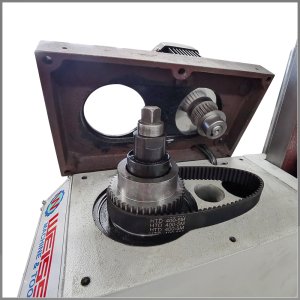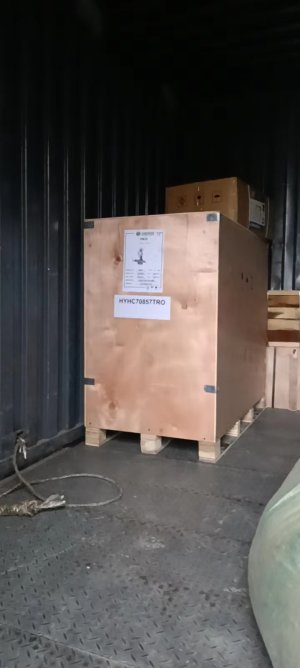I haven't had too much trouble, but I got in there early when the high low shift was acting up and found that the shaft that controls the shift fork didn't have a location hole drill in the right place so, I think it was, the low speed wasn't totally engaging. With the plastic gear that could have been an early failure. I made a new shaft to correct that. When I was in there I noticed that the light grease they were using had mostly been thrown off the gears. I found some grease from Petro-Can that had a high adhesive value and have been using that ever since. For anybody that is interested it is called G124 grease and it comes in cartridges. I use it on the change gears in the lathe also. In there it stays on the gears and doesn't get thrown onto the belt.
-
Scam Alert. Members are reminded to NOT send money to buy anything. Don't buy things remote and have it shipped - go get it yourself, pay in person, and take your equipment with you. Scammers have burned people on this forum. Urgency, secrecy, excuses, selling for friend, newish members, FUD, are RED FLAGS. A video conference call is not adequate assurance. Face to face interactions are required. Please report suspicions to the forum admins. Stay Safe - anyone can get scammed.
-
Several Regions have held meetups already, but others are being planned or are evaluating the interest. The Calgary Area Meetup is set for Saturday July 12th at 10am. The signup thread is here! Arbutus has also explored interest in a Fraser Valley meetup but it seems members either missed his thread or had other plans. Let him know if you are interested in a meetup later in the year by posting here! Slowpoke is trying to pull together an Ottawa area meetup later this summer. No date has been selected yet, so let him know if you are interested here! We are not aware of any other meetups being planned this year. If you are interested in doing something in your area, let everyone know and make it happen! Meetups are a great way to make new machining friends and get hands on help in your area. Don’t be shy, sign up and come, or plan your own meetup!
You are using an out of date browser. It may not display this or other websites correctly.
You should upgrade or use an alternative browser.
You should upgrade or use an alternative browser.
DavidR8's shop shenanigans
- Thread starter David
- Start date
I’m very curious to see what the motor/belt arrangement looks like on my mill.I haven't had too much trouble, but I got in there early when the high low shift was acting up and found that the shaft that controls the shift fork didn't have a location hole drill in the right place so, I think it was, the low speed wasn't totally engaging. With the plastic gear that could have been an early failure. I made a new shaft to correct that. When I was in there I noticed that the light grease they were using had mostly been thrown off the gears. I found some grease from Petro-Can that had a high adhesive value and have been using that ever since. For anybody that is interested it is called G124 grease and it comes in cartridges. I use it on the change gears in the lathe also. In there it stays on the gears and doesn't get thrown onto the belt.
Picked up my rewired motor and switch today. Best $80 I spent in a while.
And my TouchDRO adapter arrived today. Did a trial assembly and shocking no one more than myself it works with the Z scale I have. The other scale is due this week.
And my TouchDRO adapter arrived today. Did a trial assembly and shocking no one more than myself it works with the Z scale I have. The other scale is due this week.
Just working from this: https://www.touchdro.com/store/diy-dro-glass-scale-adapter-v2.html#documentationDid he give you a schematic?
I bought the pre-built kit so all I have to do is figure out the pinout on my scales.
Oh whoops no he didn't but it would be easy enough to draw one up.I meant for the rewound motor/switch for future reference.
Oh whoops no he didn't but it would be easy enough to draw one up.
Please share that.
Just working from this: https://www.touchdro.com/store/diy-dro-glass-scale-adapter-v2.html#documentation
I bought the pre-built kit so all I have to do is figure out the pinout on my scales.
I could not resist a peek at the unit's docs. I noticed that it also has an rpm input and a probe input. According the manual, the probe is a tool setter for CNC.
But I just got a tool setter to evaluate for Z-Axis edge finding w/o cnc. The way I'm thinking is to put the tool setter on the bottom of the vise jaws, touch off the probe and set zero (or an offset) on the DRO Z Axis. This makes the bottom of the part the Z-Axis zero edge. A table of offsets could be used to compensate for parallels. In a discussion on this with @thestelster, he also suggested I might be able to use the tool table function for the parallels.
I know that you are planning to go cnc, but those of us who are not planning to swim with sharks would appreciate any insights you might gain for us too.
I have no intentions of going CNC on my mill. Not sure what might have given you that impression.I could not resist a peek at the unit's docs. I noticed that it also has an rpm input and a probe input. According the manual, the probe is a tool setter for CNC.
But I just got a tool setter to evaluate for Z-Axis edge finding w/o cnc. The way I'm thinking is to put the tool setter on the bottom of the vise jaws, touch off the probe and set zero (or an offset) on the DRO Z Axis. This makes the bottom of the part the Z-Axis zero edge. A table of offsets could be used to compensate for parallels. In a discussion on this with @thestelster, he also suggested I might be able to use the tool table function for the parallels.
I know that you are planning to go cnc, but those of us who are not planning to swim with sharks would appreciate any insights you might gain for us too.
You will go to the dark side! You just don't know it yet.I have no intentions of going CNC on my mill. Not sure what might have given you that impression.
Former Member
Guest
Yeap!You will go to the dark side! You just don't know it yet.
might have been your laser engraver, CNC router?Not sure what might have given you that impression.
Likely yes. I'm only half in the CNC camp 🙂might have been your laser engraver, CNC router?
I have no intentions of going CNC on my mill. Not sure what might have given you that impression.
I don't know, but I did. Glad to hear I dreamed it. You will be ok as long as you stay away from anything remotely resembling dark side cool aide.
Former Member
Guest
It can be done......


